Card switch: what is it for, how to choose it and connect it correctly
Modern houses have many rooms and many household electrical appliances.When leaving home, leaving most electrical equipment on is unprofitable due to wasted electricity consumption.
You have to spend time going around the rooms, turning off appliances and lights. There is a device that can turn off power to all “extra” electrical networks with one movement - a switch with a card.
In this material we will take a detailed look at the principles of operation of card switches, their types and installation features.
The content of the article:
- Principles of home energy conservation
- Purpose of the card switch
- Benefits from a card reader in a residential building
- Switchable and non-switchable subnetworks of electrical appliances
- Types of card reader switches
- Features of installing card reader switches
- Card energy saving switch in a residential building
- Conclusions and useful video on the topic
Principles of home energy conservation
Until the 90s, city apartments were equipped with the largest number of household appliances. For country houses, local power grids simply did not have enough capacity - even the refrigerator worked intermittently.
And there were few affordable household electrical appliances in those years - a TV, a refrigerator, a washing machine, a vacuum cleaner, a stereo and a radio.
Finally, the cost of an electric kilowatt at that time was low - leaving a lamp in the room or a radio receiver on only slightly increased the cost of paying for electricity.
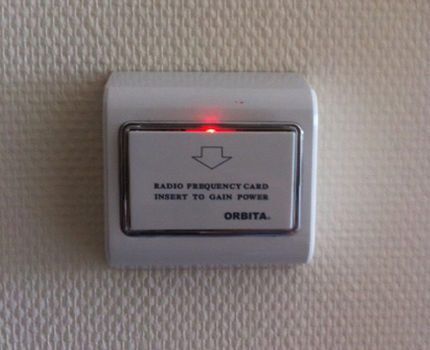
households, contributing to the best reduction in energy costs. Leaving appliances on in an empty house is a waste of money
Today the situation is different: in every apartment house there are quite a few electrical appliances. It's one thing to monitor five or six household electricity consumers like a TV or a room lamp. It's quite another to try to track 20 or more devices that are regularly connected to the power grid.
The rhythm of modern life does not allow this; there is always no time. But there is no desire to pay for extra kilowatts wasted by “forgotten” gadgets.
Card switches allow you to save household energy. Having installed the card reader near the front door, all you have to do is remove the card from it every time there is no one else left in the house - all excess power lines will be de-energized.
Of course, the card electrical installation product is not capable of deciding which internal power grids of the house to de-energize. However, it must be correctly integrated into the home power supply network.
Purpose of the card switch
This energy limiting device has been used in hotels for many years. The room key card is inserted into the card reader after opening the door lock - the lighting and household appliances (air conditioning, TV, etc.) are turned on in the rooms.
When leaving the hotel room, the guest must remove the card from the "pocket" of the switch, de-energizing the secondary power systems.
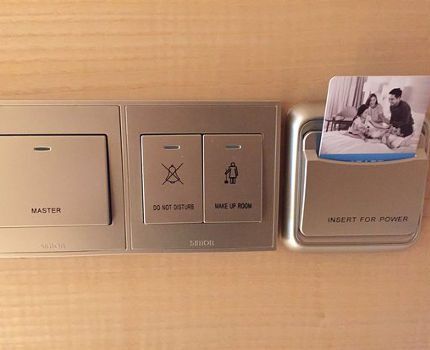
Modern active power management card readers also ensure the safety of hotel property from staff (for example, the contents of a bar)
In this way, the hotel optimizes energy costs.Guests must pick up the key card when leaving the room, which means they will not be able to leave the light on in the bathroom or the TV and air conditioning on.
Let's estimate the scale of savings. For example, a 22 W LED lamp left on for 10 hours will consume 220 W of electricity. Over the course of a year, such a lamp will waste 80.3 kW (there is no one in the room).
In Moscow, at a tariff of 5.38 rubles, a lamp left running for a year will “burn” 432 rubles. Externally there are not many, but there are dozens of such lamps in the hotel. And taking into account TVs, air conditioners and other electrical appliances that are not turned off, the amount accrues to a decent amount.
In addition to the function of de-energizing the electrical subnetwork, the card reader switch can be used to shut off the water supply during the absence of household members.
You just need to equip the water supply inlets with special (normally closed) water supply shutoff valves and connect the wired power supply group from them to the card device.
Benefits from a card reader in a residential building
For hotels, equipping rooms with card switches is a necessary measure to save energy costs. But is a similar device really necessary for a residential building?
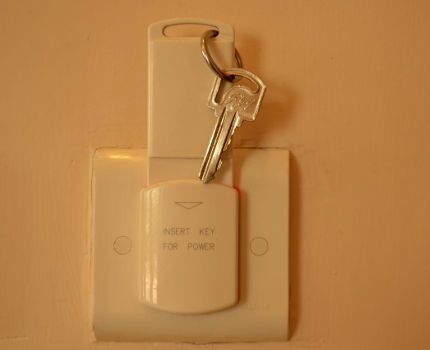
There are contact and key fob switches. The latter are more convenient, since the switch also serves as a “storage place” for the key fob
If the apartment or cottage has less than four to five rooms (including a kitchen, bathroom, etc.), then dividing the home power network into essential and secondary lines with de-energization of the latter in the absence of household members, in principle, is not particularly necessary.
It’s easier to keep track of a small number of rooms yourself than to build a divided energy supply “tied” to a card reader.
However, the modern reality of public services, which has developed in many cities, forces apartment owners to abandon the central supply of thermal energy - to install electric boilers, mount warm floor with electric heating elements.
Leaving the house for many hours and leaving the thermal energy generation systems in active mode, the owner of even a small home wastes money.
Regarding residential real estate with an area of more than 80 m2 – using a card switch in such a house is certainly beneficial. But connecting disconnected household power lines to a card reader switch is appropriate only in situations where there are no household members in the house for a long time.
For example, if the apartment is empty from the morning (household members go to work/study) until the evening, or a country cottage visited by the owners from time to time.
Switchable and non-switchable subnetworks of electrical appliances
Modern electrical wiring complex in residential buildings it is formed by several independent groups, displayed on separate machines in the panel.
Main goals: simplifying future repair tasks and allowing the use of cables of different (required) cross-sections. An extension of these goals will be the division of electrical wiring groups into two subnetworks - the main (non-switchable) and secondary (switchable).
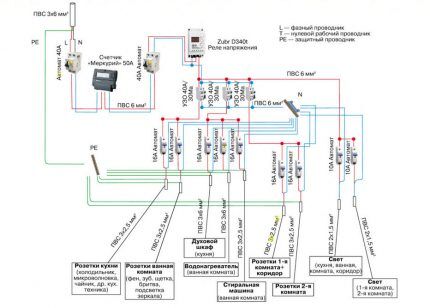
reasons, including the ability to control power for optional groups (subnets). In the image
an approximate diagram of the formation of groups of a house electrical network is presented
Non-disabled subnet. It includes power points for household appliances that require constant power supply - refrigerator, electric stove and microwave. Power for the last two types of household appliances is usually necessary for the operation of the clock built into them.
Also, continuous power supply is useful for an automatic washing machine - it can operate in the “delayed wash” mode without the participation of the owner. The computer may need to work in the absence of the owners.
For example, for downloading large files from the Internet. The wiring groups of the non-switchable subnetwork of the house are output to automatic circuit breakers in the electrical panel.
Disabled subnet. It includes all groups of lighting devices (main, auxiliary, scenic lighting, etc.) and power points (sockets) to which equipment from a non-switchable subnet is not connected.
The disconnected subnetwork also includes electrical wiring groups that power household appliances, the operation of which is not needed in the absence of household members - for example, a boiler and split system, a TV and kitchen hood, heated floors on electric heating elements, etc.
The groups of the subnet to be switched off are connected to a common switch - the card reader.
Types of card reader switches
Having a similar operating principle, energy-saving switches differ in simple and more complex ones. The former are suitable for apartments and houses of a relatively small area, the latter will be most convenient in residential complexes with a large number of rooms equipped with numerous electrical equipment.
If there is no card in the “pocket”, then the switch contacts are closed - external power supply is not supplied to the premises’ subnetworks.
By inserting a card with certain characteristics, the user closes the contacts of the device, activating the supply of electricity to power points in the premises. Typical card sizes for an energy-saving switch: length from 80 mm; width up to 54 mm; thickness from 0.8 to 1.2 mm.
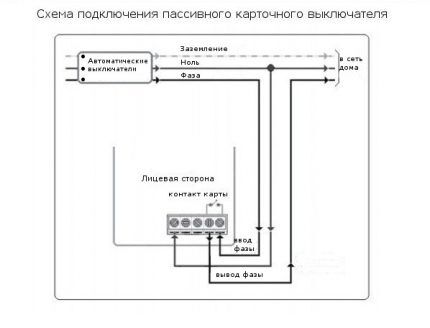
electricity is achieved by interrupting the network through phase wiring
Simple switches (passive)
Turning on the power supply in the electrical network controlled by such a switch can be done either using a standard key card or any other card of a similar size. For example, you can insert a business card or a leaf of a calendar to turn on the card reader for power supply.
Such devices are inexpensive and quite effective, so they are used in many hotel and residential complexes.
The ability to replace the original card with a cardboard fragment of the same shape simplifies the task of reproducing a card key in case of loss of standard samples or the need for more of them (for a cleaning lady, for example).
Improved switches (active)
The key card for such devices contains a chip that activates switches of only a certain standard - Temic, Emmarin, Mifare, etc.
Being a full-fledged element of an access control system with the ability to integrate into an online access control system for residential premises, an active card reader will not perceive a counterfeit card (for example, made from cardboard) as a valid key.

more complex organization.However, the subnetworks connected to the card reader should be configured correctly - with the expectation of long-term use by owners and service personnel
Smart switches (smart devices)
They are equipped with key cards that can not only determine whether a key belongs to a given system, but also recognize the range of its capabilities. Those. Activation of power in the entire subnet occurs only with the card of the owner of the house inserted into the card reader.
If a cleaning staff card is inserted into the smart card reader, the power supply to strictly defined network groups will be turned on. The cleaning lady's card activates the power supply for the lighting and several outlets needed to connect the vacuum cleaner, but, for example, the Jacuzzi bathtub and TV will remain de-energized.
Please note that with the exception of the key cards of home owners, all other cards for the smart card reader are correctly programmed (a programming device is required) with restrictions set for each of them. Of course, the card receiving unit also needs programmable entry of network power access scenarios for each key card.
Features of installing card reader switches
It is optimal if card devices intended for managing the power supply of household subnetworks are designed for a voltage of 220V and a current of 30A. This will allow the switches to safely switch the current of the network group to which the most energy-intensive household appliances are connected.
At lower performance levels, but with the need to manage network groups with multiple power consumers, the load on the energy saving switch will be too high.
For example, among household appliances that place an increased load on the electrical network, we can highlight a washing machine, a split system and an electric kettle. Therefore, models of card receiving switches designed for a current of less than 30A should be equipped with an additional starter.
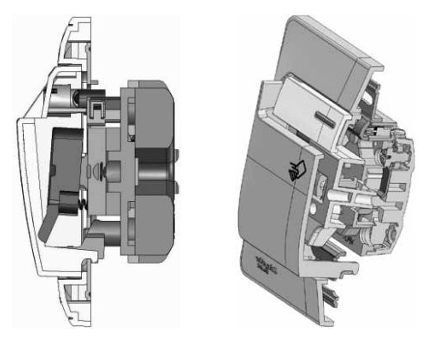
The installation structure of the card capture reader is formed by two main elements - the main body (mechanism) of the device and the mounting frame. The body of the main mechanism of card capture devices of some brands is equipped with a removable decorative insert.
Let's look at the installation procedure for a card switch using the Schneider Electric model as an example:
- Using a screwdriver, pick up the decorative insert on the mechanism body and remove it. Unscrew the two mounting screws;
- remove the frame and cover;
- secure the power line wires by inserting their ends stripped of braiding into the contact clamps corresponding to the diagram, tighten with screws;
- insert the housing into the cavity of the mounting box. Depending on the type of mounting box used, either tighten the spacer tabs with two screws, or screw in two self-tapping screws;
- put a frame. Position the cover, sliding it along the frame from top to bottom until the locking tabs engage;
- tighten two screws and install the decorative trim.
The card device is installed in plastic mounting boxes designed for expansion with claws (GOST 8594-80) or for fastening with self-tapping screws. In any case, tighten the screws one by one and gradually.
Card energy saving switch in a residential building
In everyday life, it is most convenient to use a passive type card capture device: it does not require programming; identical cards; It is permissible to use homemade cards (for example, cardboard) of a suitable size.
Alternatively, you don’t have to take the card with you - put it or hang it next to the switch, then the key card will not be lost or forgotten somewhere outside the house.
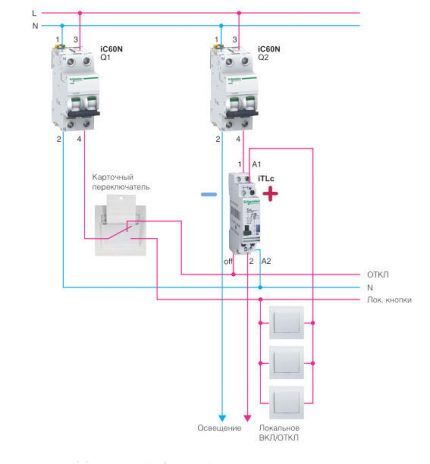
For active devices and smart switches, you will need a clear distribution of key cards by access level: main cards (activating all energy subsystems) - for home owners; limited (activating some power points) cards - for service personnel (cleaners, gardeners, etc.).
Each active card is programmed in a special device for the access level, then marked for visual recognition.
It should be taken into account that one day the owner will forget his active key card outside the house, and there is simply no other way to start the power supply to the home. Therefore, in addition to the main access cards that household members carry with them, it is necessary to keep one or two copies of the programmed cards in the house as spare ones.
Conclusions and useful video on the topic
After removing the card from the “pocket” of the switch, the home subnets will be de-energized within 30 seconds:
The wizard explains how to correctly connect a passive type card device to the serviced subnet:
A card-controlled switch, along with energy savings, will allow you to turn on the lights in the entire house with one movement, which is convenient. After all, in the twilight of the evening it can be difficult to find the switch key in another room. The card reader is a simple device, but it has many benefits.
Do you want to ask a question about the topic of the article, have you found any shortcomings in the material, or have valuable information that you can share with our readers? Please leave comments in the block below.




The idea for residential premises is, in principle, good, taking into account the fact that new apartments should already be delivered with electrical wiring divided into subnetworks and optimized for such switches. Otherwise, the question arises - why do I need all this spending on rewiring? I’d rather save manually, carefully ensure that no one leaves the light on in the toilet, etc. In general, everything is as always.))
I partially agree with you. The switch system described in the article is quite practical, but as for me, it is still morally and physically outdated. Networks, subnets - all this is too complicated for the common man and the average citizen.
That’s why smart Chinese have long flooded us with Wi-Fi bulbs and Wi-Fi sockets. This is much easier than changing the wiring and building a network. In addition, even a schoolchild can assemble and connect such a system.
For example, a Wi-Fi light bulb - I left home in a hurry and forgot to turn it off, I remembered and went to work from my smartphone and corrected the situation. It’s the same story with a Wi-Fi outlet: you’re on your way home and want to come and buy something right away, turn on the boiler from your smartphone and let it heat up when you arrive. Everything ingenious is simple.
Such switches were not intended for use in a residential apartment. They were invented for hotels, holiday homes, etc.
I can’t imagine how full the house must be of constantly running equipment for such a switch to pay for itself. It is suitable for hotels, offices, and production. But in an ordinary apartment, in my opinion, it is useless. Not to mention that the card is easy to lose, break, etc. And then, if someone from the family comes earlier and doesn’t have a card, what will he do? Some extra complications.
For an apartment it may be useless, but if it is a large cottage, then it is much easier to turn off the electricity with a card than to run around the floors and rooms and check whether everything is turned off.
The card should always be at home, somewhere near the switch, so that there are no problems for any of the household members.
Valera, Amir outlined such prospects for you in the comment above, but you – the map can be lost or broken. Already today the Japanese offer refrigerators that remind you that it’s time to buy eggs, meat…. Some refrigerators order delivery. Smart irons, sensing that they have been turned on for a long time but are not being used, send a question to the owner’s mobile phone: can I turn it off? Having received no response, they turn off on their own.
Why is this in an apartment/house? If you turn it off when leaving, why use a card? Why not with a regular switch or with the help of setting the security alarm? Application only hotels, etc.